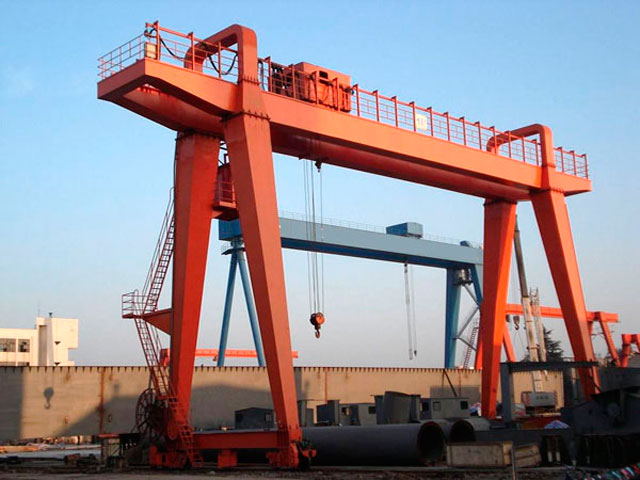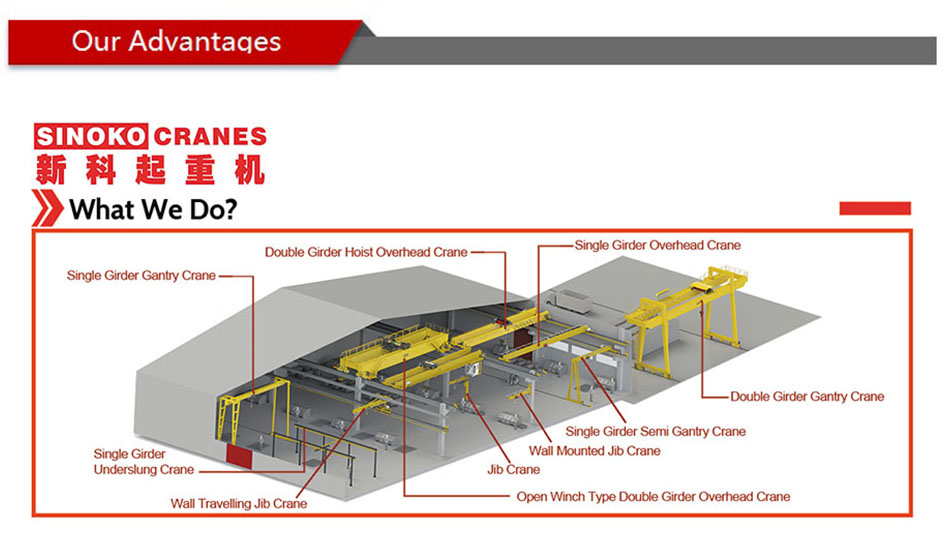Crane refers to a multi-action hoisting machinery that vertically lifts and horizontally transports heavy objects within a certain range. Also known as crane, aerial crane, and crane.
The main feature of the tire crane is: its driving cab and lifting control room are combined into one. It is evolved from a crawler crane (crawler crane). The shortcomings of crawler crane (crawler crane) crawler plates causing damage to the road surface are classified as material handling machinery.
The bridge crane is a lifting equipment that is horizontally framed over the workshop, warehouse and material yard for material lifting. Because its two ends are located on tall concrete columns or metal supports, it is shaped like a bridge. The bridge frame of the bridge crane runs longitudinally along the tracks laid on both sides of the elevated frame, which can make full use of the space under the bridge frame to lift materials without being hindered by ground equipment. It is the most widely used and the largest number of cranes.

Some of the working characteristics of lifting equipment are intermittent movement, that is, the corresponding mechanism of reclaiming, transporting, unloading and other actions in a working cycle is alternately working. The development and use of cranes in the market are becoming more and more extensive. Due to the fact that there are often some accidents without outriggers and lifting, the speed of travel is also faster than crawler cranes (crawler cranes); the operation is stable, the lifting capacity is large, and the lifting can be carried in a specific range, but the road must be smooth and solid. , The tire pressure meets the requirements, and the lifting shall not exceed 50cm from the ground; long-distance walking with load is prohibited. In order to ensure the safety of the operation, it is basically forbidden to carry out hoisting operations without hitting the outriggers in China. The types of steel wire ropes used for cranes include phosphating-coated steel wire rope, galvanized steel wire rope and smooth steel wire rope. In 10 BC, the ancient Roman architect Vitruvius described a crane in his construction manual. This machine has a mast with a pulley on the top of the pole. The position of the mast is fixed by a cable, and the cable passing through the pulley is pulled by a winch to lift heavy objects. Some overweight machinery can use two masts to form a herringbone shape to move the hoisted objects laterally, but the amplitude is small and the operation is very laborious.
It was not until the 15th century that Italy invented the jib crane to solve this problem. This crane has an inclined cantilever, and the top of the boom is equipped with pulleys, which can be lifted and rotated. But until the 18th century, all kinds of hoisting machinery used by humans were powered by human or animal power, and they were very limited in terms of lifting weight, range of use, and work efficiency.
In the middle and late 18th century, British Watt improved and invented the steam engine, which provided power conditions for hoisting machinery. In 1805, Glenn engineer Lenney built the first steam cranes for the London Dockyard. In 1846, Armstrong of England changed a steam crane in the Newcastle Dockyard to a hydraulic crane.
In the early 20th century, Europe began to use tower cranes.
Cranes mainly include hoisting mechanism, operating mechanism, luffing mechanism, slewing mechanism and metal structure. The hoisting mechanism is the basic working mechanism of a crane, mostly composed of a hanging system and a winch, and some lift heavy objects through a hydraulic system. The running mechanism is used to move heavy objects longitudinally and horizontally or adjust the working position of the crane. It is generally composed of a motor, a reducer, a brake and wheels. The luffing mechanism is only equipped on jib cranes. The amplitude decreases when the boom is raised and increases when it is lowered. There are two types: balanced luffing and unbalanced luffing. The slewing mechanism is used to rotate the boom, and is composed of a driving device and a slewing support device.
Sinokocranes is professional crane manufacturer. We integrate crane research and development, manufacturing, sales, installation and service.Product including overhead crane, gantry crane, jib crane, electric hoist, crane trolley,magnet,grab and related lifting equipment,etc.

Come and contact us!👇